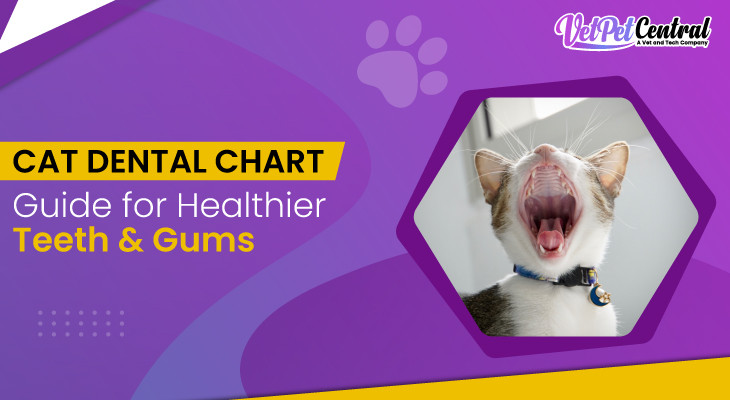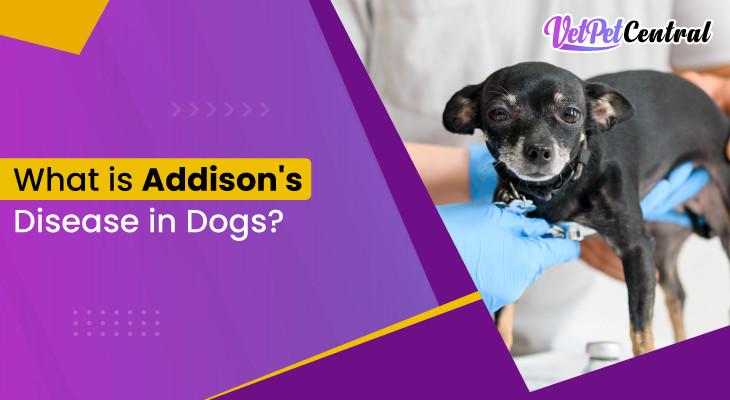Cat Dental Chart Guide for Healthier Teeth and Gums
 Mar 17, 2025
Mar 17, 2025

Dental health plays an integral part in your cat's overall well-being. Poor dental health can result in dangerous oral diseases, from infection to tooth loss to sickness. Learning a cat dental chart will enable you to monitor your cat's dental health, catch any signs of a forthcoming problem in good time, and watch your cat have a lifetime of long-lived, healthy teeth.
However, most pet owners pay little or no attention to the cat's dental health. This blog thoroughly covers feline dental charts, why they are essential, and how to use them for the dental well-being of your cat.
Understanding the Cat Dental Chart
A feline dental chart represents the cat’s teeth structure and numbering. This chart categorizes each tooth by position in the upper and lower jaws. A detailed chart of cats’ teeth helps veterinarians and pet owners assess dental health and detect abnormalities.
Feline Teeth Numbers and Structure
Cats have 30 permanent teeth. However, kittens have 26 deciduous teeth. These teeth are categorized as follows:
- 12 Incisors
These are the Small front teeth used for grooming and grasping food.
- 4 Canines
Canines are long, pointed teeth for tearing meat.
- 10 Premolars
Premolars are situated behind the canines, cut and shear food.
- 4 Molars
Molars are at the back of the mouth. These teeth are used to grind food.
What Is the Feline Dental Formula?
The feline dental formula is a way to describe the number and types of teeth in a cat’s mouth. It is expressed as a fraction, with the upper jaw (maxilla) teeth listed above the line and the lower jaw (mandible) teeth below the line.
Deciduous (Kitten) Dental Formula
The dental formula for kitten or deciduous teeth is:
- 2 × (I 3/3, C 1/1, P 3/2) = 26 teeth
Here is the explanation of this formula:
- 3 Incisors (I) on the upper and lower jaws.
- 1 Canine (C) on each side of the upper and lower jaws.
- 3 Premolars (P) on each side of the upper jaw, but only 2 Premolars on each side of the lower jaw.
Permanent (Adult Cat) Dental Formula
The dental formula for an adult cat is:
- 2 × (I 3/3, C 1/1, P 3/2, M 1/1) = 30 teeth
Here is the explanation of this formula:
- Same number of Incisors, Canines, and Premolars as kittens.
- 1 Molar (M) on both upper and lower jaws.
Feline Denture Chart and Tooth Numbers
A feline dental chart follows the Modified Triadan System, a standardized numbering system used in veterinary dentistry. It divides a cat’s mouth into four quadrants:
- Right upper jaw (100 series)
- Left upper jaw (200 series)
- Left lower jaw (300 series)
- Right lower jaw (400 series)
Each tooth is assigned a three-digit number based on its quadrant and position. For instance:
- The upper right canine tooth is 104.
- The lower left first molar is 309.
A Feline Dental Chart Importance
A cat dental chart is essential for monitoring a cat’s oral health. It helps:
- Track dental development in kittens and adults.
- Identify missing, broken, or misaligned teeth.
- Diagnose and record dental diseases.
- Monitor gum recession, plaque, and tartar buildup.
- Plan and track extractions or dental treatments.
What are the Common Dental Problems in Cats?
Cats suffer from several dental issues that can impact their overall health. Regularly referencing a dental chart for cats can help you detect early warning signs.
1: Gingivitis
Gingivitis is the inflammation of the gums due to plaque buildup. Signs include:
- Red, swollen gums
- Bad breath
- Bleeding while eating or chewing
2: Periodontal Disease
Untreated gingivitis can lead to periodontal disease, where bacteria destroy gum tissue and bone structure. This condition can cause:
- Tooth loss
- Severe pain
- Systemic infections affecting the kidneys, heart, and liver
To maintain your feline and canine dental health, learn how to prevent periodontal disease in pets.
3: Tooth Resorption
Tooth resorption occurs when a cat’s tooth begins breaking down and dissolving. This is a painful condition and often leads to extractions. Symptoms include:
- Difficulty in chewing
- Pawing at the mouth
- Excessive drooling
4. Stomatitis
Feline stomatitis is a severe inflammation of the mouth lining. It causes:
- Extreme pain
- Loss of appetite
- Ulcers and bleeding gums
5: Broken or Fractured Teeth
Cats may break teeth due to accidents, falls, or chewing on complex objects. A broken tooth can expose the pulp and lead to infections.
How to Maintain Your Cat’s Dental Health?
Preventive care is essential for maintaining good feline dental health. Here are some key practices:
1: Routine Veterinary Checkups
Regular veterinary dental exams can detect issues before they become severe. Your veterinarian will use a feline dental chart number to assess tooth and gum health.
2: Brushing Your Cat’s Teeth
Daily brushing helps prevent plaque buildup. Pet owners can use:
- A pet-safe toothbrush
- Feline-specific toothpaste (never use human toothpaste, as it is toxic to cats)
- Slow, gentle strokes to avoid distressing your cat
3: Providing Dental Treats and Toys
Dental treats and chew toys can help reduce plaque and tartar buildup. Look for products approved by veterinary dental associations.
4: Feeding a Dental-Friendly Diet
Specific diets support oral health, including:
- Prescription dental diets designed to clean teeth while chewing
- Dry kibble formulated for dental care
- Raw bones (consult your veterinarian first)
5: Professional Dental Cleanings
Annual cleanings by a veterinarian help remove stubborn tartar and detect hidden dental diseases.
Learn how to keep your pet’s teeth safe from periodontal disease.
How are the Cat and Dog Dental Charts Different?
Even though both cats and dogs possess dental charts, there are significant differences:
- Dogs have 42 permanent teeth, while cats have 30.
- Canines are more prominent and capable of chewing on bones and larger prey.
- A canine dental chart with roots has root structures that, in canines, are longer and more complicated than cats.
- Cats have a high chance of tooth resorption, whereas dogs are more prone to broken teeth due to aggressive chewing.
When Does Your Cat Need Dental Care?
Look for these symptoms that indicate dental problems:
- Bad breath
- Difficulty eating or chewing on one side
- Excessive drooling
- Bleeding or swollen gums
- Pawing at the mouth
- Weight loss due to reduced appetite
Steps to Conduct a Home Dental Check
You can perform basic dental assessments at home using a feline teeth chart:
- Gently lift your cat’s lips to inspect their gums and teeth.
- Look for tartar buildup (yellow or brown spots on teeth).
- Check for red, swollen, or bleeding gums.
- Examine for misplaced, loose, or missing teeth.
- Watch for food intake for difficulty chewing or loss of appetite.
If you spot any abnormality, make a vet appointment right away.
Conclusion
A dental chart for your cat is well worth having to maintain your cat's oral health. Recognizing your cat's teeth numbering system, understanding early disease symptoms, and following preventive regimens can make your feline friend a happier, healthier animal.
Routine checkups with your vet, a healthy diet, and frequent dental care will prevent major dental issues. Take the initiative and ask your vet for specific dental care guidelines.




